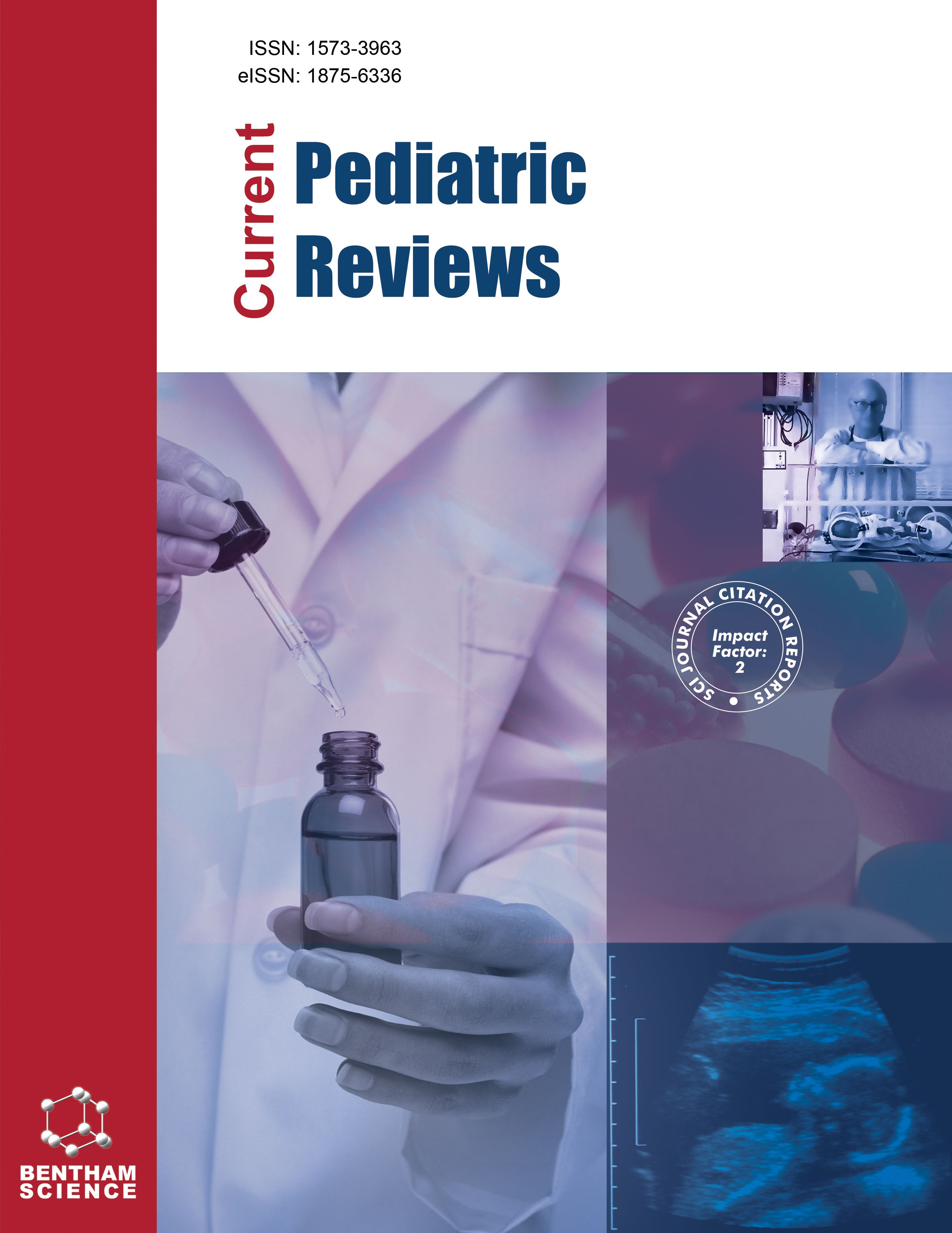- Home
- A-Z Publications
- Current Pediatric Reviews
- Previous Issues
- Volume 4, Issue 2, 2008
Current Pediatric Reviews - Volume 4, Issue 2, 2008
Volume 4, Issue 2, 2008
-
-
Perinatal Depression, Fetal Bonding, and Mother-Child Attachment: A Review of the Literature
More LessAuthors: Shaila Misri and Kristin KendrickMaternal depression during pregnancy and the postpartum period has been associated with a variety of consequences in the fetus and newborn. In particular, depression has been shown to compromise maternal bonding to her fetus antenatally, and mother-infant interaction and attachment patterns during the postpartum period. In turn, these alterations in the relationship between a mother and her infant can impact the chil Read More
-
-
-
Perinatal Brain Injury
More LessAuthors: Sailesh Kumar, Lisa Story and Mellisa DamodaramPerinatal brain injury is an important cause of both early and long term morbidity and mortality. The pathophysiology of perinatal brain injury is complex, and often gestation dependent. Ultrasound has traditionally been the imaging modality of choice used to diagnose these lesions; however, the advent of Magnetic Resonance Imaging (MRI) has improved diagnosis and has enabled the correlation of lesions in the neonatal peri Read More
-
-
-
Neonatal Diabetes: Applying Molecular Biology to Patient Care
More LessAuthors: Rebecca Vartanian and Steven M. DonnNeonatal diabetes mellitus (NDM) is a rare cause of hyperglycemia in the neonatal period. We encountered a patient with neonatal diabetes mellitus and exocrine pancreatic insufficiency secondary to a homozygous insulin promoter factor-1 (IPF1) mutation. We sought to review the available literature regarding current etiologies and therapeutic options available to patients with NDM. Identification of genetic mutatio Read More
-
-
-
Neonatal Fever in the Term Infant: Evaluation and Management Strategies
More LessAuthors: Joseph M. Geskey, Michael J. Beck and Gretchen L. BrummelThe presence of fever in the neonatal period demands urgent evaluation from healthcare providers since signs and symptoms of a serious bacterial infection in this age group can be nonspecific. Current practice guidelines recommend that febrile neonates should be presumed to have a serious bacterial infection and undergo a sepsis evaluation and hospitalization until the results of diagnostic testing are known. Howev Read More
-
-
-
Probiotics; Past, Present, and Future Perspectives
More LessThe origin of probiotics and the use of fermented foods and cultured milk products are quite ancient. However, it was not until the turn of the 20th century that Metchnikoff made intelligent observations that human longevity and health are associated with the consumption of lactic acid bacteria. Since those observations have been made a plethora of probiotic studies in adults and children have been performed. The purpose of th Read More
-
-
-
Oesophagogastric Disconnection: Who, How and When? A Review Article
More LessAuthors: Miss F. Verey and Miss Eleri CusickSevere Gastro-oesophageal reflux disease (GORD) is a disabling condition, causing significant morbidity and mortality. Fundoplication has long been seen as the gold standard operative solution, but in 5-43% of patients it will fail. Oesophagogastric disconnection or dissociation (OGD) is a relatively new procedure used for severe GORD. With this review we look at the current literature on the indications and outcomes after oesopha Read More
-
-
-
Factors Influencing Body Mass Index, Appetite Control, and the Role of Glutamate and Excess Nutritional Protein During Child Development: A Review
More LessAuthors: Michael Hermanussen and Jesus A. F. TresguerresObesity has become a major public health concern in this century. Yet, the widespread popularisation in managing overweight and obesity indicates that the problem of body weight maintenance has developed from an only medical into an interdisciplinary and already political problem. Current ideas about lifestyle and strategies to maintain health and weight have become dominated by increasingly popular beliefs that contrast Read More
-
-
-
Nocturnal Enuresis in Children: A Review of the Literature
More LessNocturnal enuresis (NE) is a very common clinical disorder. According to DSM-IV, NE is defined as repeated voiding, accidental or on purpose, into clothing or into the bed, at least twice a week, for 3 consecutive months, in children older than 5 years, age in which the sfincterial control is acquired. The pathophysiology of NE is not fully understood. It has been suggested that NE is the result of a combination of osmoregulat Read More
-
-
-
How Accurate is Subjective Reporting of Childhood Sleep Patterns? A Review of the Literature and Implications for Practice
More LessAuthors: Kim M. Bauer and Sarah BlundenReduced sleep duration has been implicated in a range of negative and consequential physiological and psychological daytime problems. Detection strategies such as polysomnography, actigraphy, and subjective reports have been utilised to assess paediatric sleep patterns such as sleep duration, and problems in both clinical and non-clinical samples. Although objective assessments have more validity in assessing and dia Read More
-
Volumes & issues
-
Volume 21 (2025)
-
Volume 20 (2024)
-
Volume 19 (2023)
-
Volume 18 (2022)
-
Volume 17 (2021)
-
Volume 16 (2020)
-
Volume 15 (2019)
-
Volume 14 (2018)
-
Volume 13 (2017)
-
Volume 12 (2016)
-
Volume 11 (2015)
-
Volume 10 (2014)
-
Volume 9 (2013)
-
Volume 8 (2012)
-
Volume 7 (2011)
-
Volume 6 (2010)
-
Volume 5 (2009)
-
Volume 4 (2008)
-
Volume 3 (2007)
-
Volume 2 (2006)
-
Volume 1 (2005)
Most Read This Month
Article
content/journals/cpr
Journal
10
5
false
en


